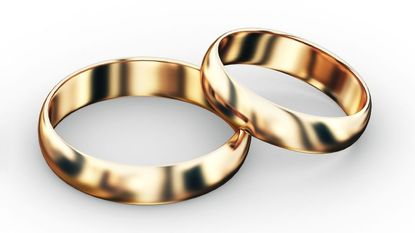Millions of couples missing out on marriage tax allowance
Married couples and civil partners are being urged to check if they qualify for the marriage allowance, which could save them up to £252 a year in tax


Millions of couples are missing out on the marriage tax allowance, which could save them up to £252 a year in tax.
More than 2.1 million couples currently benefit from the tax break, which allows husbands, wives and civil partners to transfer part of their tax-free personal allowance to their higher-earning partner.
However, HMRC estimates that 4.2 million couples stand to gain from the tax break, meaning more than 2 million couples could be missing out.
Subscribe to MoneyWeek
Subscribe to MoneyWeek today and get your first six magazine issues absolutely FREE

Sign up to Money Morning
Don't miss the latest investment and personal finances news, market analysis, plus money-saving tips with our free twice-daily newsletter
Don't miss the latest investment and personal finances news, market analysis, plus money-saving tips with our free twice-daily newsletter
In addition to this year’s allowance, couples can backdate their claim by up to four tax years, meaning they could save up to £1,242 in total.
HMRC says many people are unaware they are eligible for the tax perk, particularly couples where one partner has retired, has given up work to take on caring responsibilities, or is unable to work due to a long-term health condition.
“We want every eligible couple to benefit from marriage allowance tax relief,” said Angela MacDonald, HMRC’s deputy chief executive. “Couples whose circumstances have changed – perhaps one of them has stopped working or taken a lower-paid job – may not realise they are entitled to claim.”
What is the marriage allowance?
The marriage allowance applies to couples where one partner does not pay income tax - or their income is below the £12,570 personal allowance - and the other partner pays basic-rate income tax.
The couple must be married or in a civil partnership; cohabiting doesn’t count.
The marriage allowance works by transferring up to £1,260 of the lower-earning partner’s personal allowance to their spouse or civil partner who earns more. New tax codes are issued reflecting this.
It doesn’t matter if you are currently receiving a pension, or you live abroad - as long as you get a tax-free personal allowance, you can apply.
Both partners must have been born on or after 6 April 1935. If not, you can apply for the married couple’s allowance instead, which is worth between £364 and £941.50 a year in tax relief.
How much can I save?
The marriage allowance for the 2022/23 tax year is worth up to £252 a year. The exact amount depends on how much both partners earn. You can check how much you could save by using the government’s marriage allowance calculator.
When part of the personal allowance is transferred, one person may have to pay more tax while the other pays less tax - but the couple will still pay less tax overall.
If you're eligible and apply successfully, you'll automatically get the tax break each year in future, so you don’t need to keep reapplying.
The government will also check to see if you’re owed tax relief for previous years, going back to 2018/19. The maximum amounts for each year are:
- 2022/23 – £252
- 2021/22 – £252
- 2020/21 – £250
- 2019/20 – £250
- 2018/19 – £238
So, if you claim for this tax year and receive the maximum amount for the past four years as well, you'll get £1,242.
How do I apply?
It’s quick and easy to apply. The non-taxpayer needs to apply, which can be done on the HMRC website. You’ll get an email confirming your application within 24 hours, and a new tax code within a few days if the application is successful.
If there's a problem doing the online application, you can apply via self-assessment (if you’re already registered and send tax returns) or by writing to HMRC. You can also call 0300 200 3300 with any questions.
Make sure you apply for the marriage allowance on the official site, and don’t be tempted to use a third party. Beware searching for “marriage allowance” online, as some firms may charge you for applying. Remember that it is free to apply on the government site, and very simple.
“By applying on gov.uk, rather than through a third party, you get to keep 100% of the tax relief due,” notes MacDonald.
If your circumstances change and you’re no longer entitled to marriage allowance, you can cancel online or by calling HMRC.
Ruth is passionate about helping people feel more confident about their finances. She was previously editor of Times Money Mentor, and prior to that was deputy Money editor at The Sunday Times.
A multi-award winning journalist, Ruth started her career on a pensions magazine at the FT Group, and has also worked at Money Observer and Money Advice Service.
Outside of work, she is a mum to two young children, a magistrate and an NHS volunteer.
-
-
 Investment trust discounts hit 2008 levels. Here’s how to profit
Investment trust discounts hit 2008 levels. Here’s how to profitInvestment trust discounts have risen to levels not seen since 2008, here are three trusts looking to buy to profit.
By Rupert Hargreaves Published
-
 A luxury stock to buy at a high street price
A luxury stock to buy at a high street priceInvestors wrongly consider Watches of Switzerland a high-street outlet.
By Dr Matthew Partridge Published
-
 August NS&I Premium Bond winners unveiled - have you scooped £1m?
August NS&I Premium Bond winners unveiled - have you scooped £1m?Two lucky NS&I Premium Bond winners are now millionaires in the August draw. Find out here if you are one of them
By Tom Higgins Published
-
 Savings rates more than double in a year as challenger banks top the best buy tables
Savings rates more than double in a year as challenger banks top the best buy tablesThe best savings rates have doubled - and in some cases tripled - in a year, with challenger banks offering the highest rates. While they are still no match for inflation, we look at what you could be earning.
By Ruth Emery Published
-
 Midlife MOT: what is it and who can get one?
Midlife MOT: what is it and who can get one?The government has launched an online midlife MOT to help older workers with financial planning, health guidance and career skills. But how does it work, who can get one and would you pass it?
By Ruth Emery Published
-
 Coventry Building Society launches new best easy access savings account
Coventry Building Society launches new best easy access savings accountCoventry Building Society's deal tops our easy access savings account list, but could your cash be put to better use?
By Tom Higgins Published
-
 NS&I boosts fixed-term savings rates
NS&I boosts fixed-term savings ratesThe NS&I, the government-backed savings institution has mirrored recent rate rises seen elsewhere in the market.
By Tom Higgins Published
-
 Should you let AI give you financial advice?
Should you let AI give you financial advice?Can AI fill the financial advice gap? Kalpana Fitzpatrick looks at the pros and cons of using AI to guide your finances.
By Kalpana Fitzpatrick Published
-
 Small pension pots to be consolidated, says DWP
Small pension pots to be consolidated, says DWPWorkplace pension schemes worth less than £1,000 that become “deferred” when a saver changes jobs will be consolidated under a new system
By Ruth Emery Published
-
 Watchdog summons banks to explain paltry savings rates
Watchdog summons banks to explain paltry savings ratesSavings rates trail mortgage rates - and the financial watchdog has summoned banks to a meeting amid concerns of profiteering.
By Katie Binns Last updated









